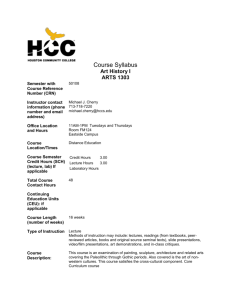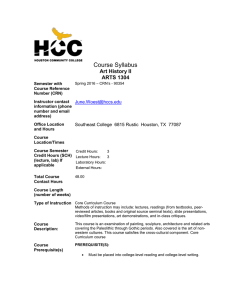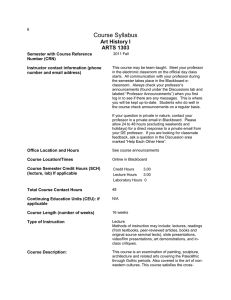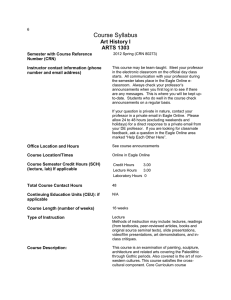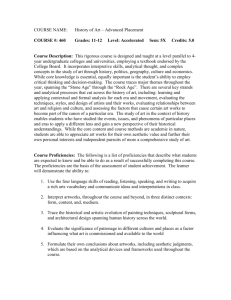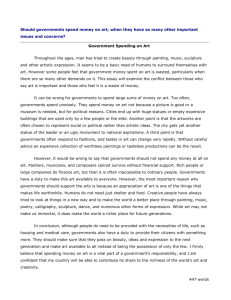1303syl62976
advertisement
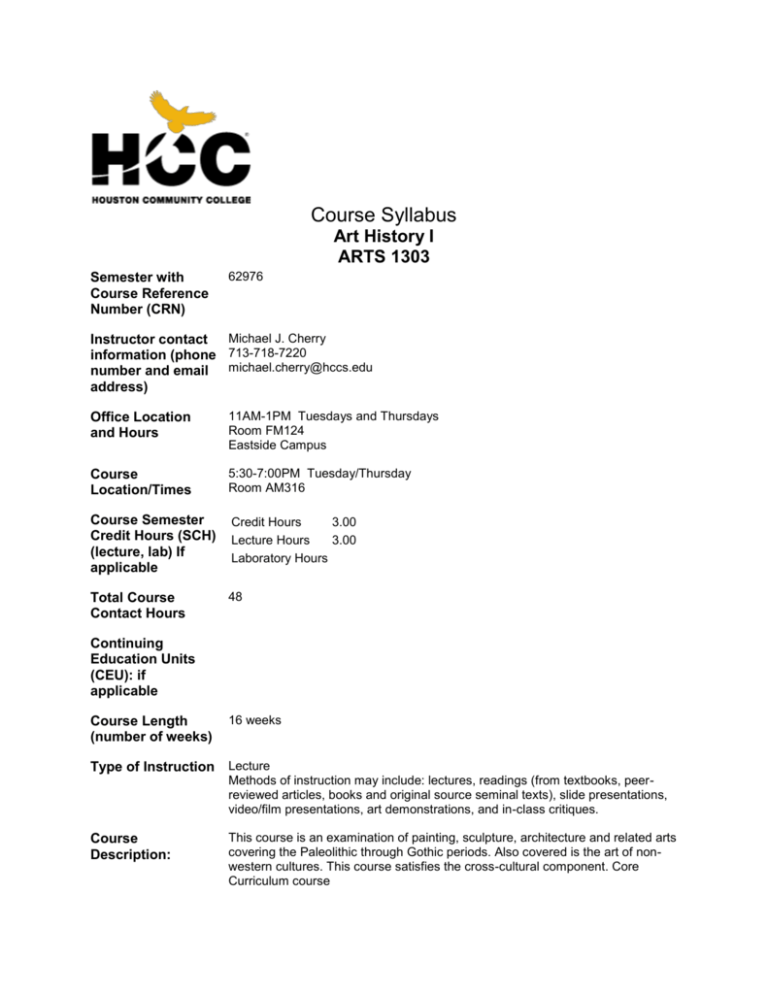
Course Syllabus Art History I ARTS 1303 Semester with Course Reference Number (CRN) 62976 Instructor contact Michael J. Cherry information (phone 713-718-7220 number and email michael.cherry@hccs.edu address) Office Location and Hours 11AM-1PM Tuesdays and Thursdays Room FM124 Eastside Campus Course Location/Times 5:30-7:00PM Tuesday/Thursday Room AM316 Course Semester Credit Hours (SCH) (lecture, lab) If applicable Credit Hours 3.00 Lecture Hours 3.00 Laboratory Hours Total Course Contact Hours 48 Continuing Education Units (CEU): if applicable Course Length (number of weeks) 16 weeks Type of Instruction Lecture Methods of instruction may include: lectures, readings (from textbooks, peerreviewed articles, books and original source seminal texts), slide presentations, video/film presentations, art demonstrations, and in-class critiques. Course Description: This course is an examination of painting, sculpture, architecture and related arts covering the Paleolithic through Gothic periods. Also covered is the art of nonwestern cultures. This course satisfies the cross-cultural component. Core Curriculum course Course Prerequisite(s) PREREQUISITE(S): Must be placed into college-level reading and college-level writing. Academic Discipline/CTE Program Learning Outcomes 1. (level 1, knowledge) Graduates will recognize the importance of integrity, accountability, artistic freedom and open-mindedness in their individual artistic production and in wide-ranging shared civic responsibility. (Adapted from HCC Values Statement.) Will care about doing honorable work Respect themselves and others Be true to themselves. Be honest with themselves. Contribute to society. Love of learning Open-mindedness Display and promote their artwork. 2. (level 3, application) Graduates are prepared for life and work in a global and technological society. (Adapted from HCC Mission Statement.) Able to continue into a 4 year B.F.A. program Live as a creative professional or use education in other profession Problem solving Display and promote their artwork. 3. (level 4, analysis) Graduates will demonstrate competence in basic art studio skills and/or art history knowledge. (Adapted from the National Association of Schools of Art – NASAD guidelines.) Safety and proficiency of tools, techniques and materials Presentation/Preparation of exhibitions and portfolios Artistic success is the result of practice and repetition. Artistic terminology Drawing fundamentals (figure, landscape, still life, abstract, etc.) Small things, ordinary things matter. 4. (level 5, synthesis) Graduates will relate knowledge, skills, discipline and responsibility to successfully live and work after graduation. (Adapted from HCC art faculty and others.) Artistic skill Communication skills (speaking and writing) Literacy skills Display and promote their artwork. Intellectual ability Small things, ordinary things matter. Teamwork and dealing with colleagues No corner cutting Creativity Innovation Having gained the basic skills that will enable them to do the things they most value Persistence Courage to try new things, to operate outside their comfort zone Interpersonal skills Business, promotional, professional and entrepreneurial skills 5. (level 6, evaluation; level 5, synthesis) Graduates can evaluate and relate art theories, elements, principles and styles in practical, day-to-day artistic experiences in their own work and in the wider contemporary world. (Adapted from the National Association of Schools of Art - NASAD guidelines.) Formal elements and principles of design Drawing skills Design and Composition skills Live as a creative professional Know when to change direction or tactics Self-evaluation A sense of lasting or sustained understanding Creativity and concept development Love of learning 6. (level 6, evaluation) Graduates will relate the high ethical and professional standards of their faculty to their own experience. (Adapted from HCC art faculty and others.) Opposed to plagiarism Copyrights Honor and fulfill commitments Keeping one’s word Having the ability to apologize after errors or misdeeds. No corner cutting Respecting others and respecting the property of others Small things, ordinary things, matter. Display and promote their artwork. Sticking up for oneself and others Value self-learning. Value lifelong learning and development. Value experience with faculty. Value collaboration with peers and classmates. Goal setting and attainment Display and promote their artwork. Value involvement with educational activities. Ability to make sacrifices for long-term goals Distinguish true success as the satisfaction of having done one’s best Course Student Learning 1. (Level 1) Identify stylistic characteristics of each of the selected cultures and period styles. Outcomes (SLO): 4 2. (Level 2) Express stylistic characteristics of each of the selected cultures and period styles. to 7 3. (Level 4) Examine the function of painting, sculpture, architecture and other arts from Prehistoric to Late Gothic time. 4. (Level 6) Appraise the function of painting, sculpture, architecture, other arts and period styles from Prehistoric to Late Gothic time. Learning Objectives (Numbering system should be linked to SLO e.g., 1.1, 1.2, 1.3, etc.) (Level 1) Identify stylistic characteristics of each of the selected cultures and period styles. SCANS and/or Core Curriculum Competencies: If applicable Core Curriculum Competencies: 1. Recognize formal elements in selected artworks of each of the selected cultures and period styles. 2. Recognize principles of design in selected artworks of each of the selected cultures and period styles. 3. Identify artistic themes of each of the selected cultures and period styles. 4. Describe the artistic roles of each of the selected cultures and period styles. 5. Know the artistic representation of artworks of each of the selected cultures and period styles. (Level 2) Express stylistic characteristics of each of the selected cultures and period styles. 1. Articulate the stylistic characteristics of various cultures. 2. Categorize the period styles from Late Gothic to present time. 3. Compare and contrast the formal elements of selected artworks. 4. Compare and contrast the principles of design of selected period styles. 5. Interpret the iconography of selected artworks. (Level 4) Examine the function of painting, sculpture, architecture and other arts from Prehistoric to Late Gothic time. 1. Identify period styles of selected artworks. 2. Differentiate period styles of selected artworks. 3. Establish stylistic characteristics of art and design from the various cultures and period styles included in the course. 4. Integrate the function of selected artworks in their historical context. (Level 6) Appraise the function of painting, sculpture, architecture, other arts and period styles from Prehistoric to Late Gothic time. 1. Summarize the period styles of selected artworks. 2. Interpret content in selected artworks. 3. Hypothesize the iconographical intent of the artist and/or producing culture of selected artworks. 4. Evaluate the formal elements and principles of design. 5. Judge the artistic merits of selected artworks. Intellectual Computer Literacy Intellectual Critical Thinking Intellectual Listening Intellectual Reading Intellectual Speaking Intellectual Writing Humanities, Visual/Performing Arts 2. To understand those works as expressions of individual and human values within an historical and social context. Humanities, Visual/Performing Arts 3. To respond critically to works in the arts and humanities. Humanities, Visual/Performing Arts 4. To engage in the creative process or interpretive performance and comprehend the physical and intellectual demands required of the author or visual or performing artist. Humanities, Visual/Performing Arts 5. To articulate an informed personal reaction to works in the arts and humanities. Humanities, Visual/Performing Arts 6. To develop an appreciation for the aesthetic principles that guide or govern the humanities and arts. Humanities, Visual/Performing Arts 7. To demonstrate knowledge of the influence of literature, philosophy, and/or the arts on intercultural experiences. Instructional Methods Face to Face Web-enhanced (49% or less) Distance (100%) Web-based Student Assignments (Level 1) Identify stylistic characteristics of each of the selected cultures and period styles. No assignments selected for this outcome (Level 2) Express stylistic characteristics of each of the selected cultures and period styles. No assignments selected for this outcome (Level 4) Examine the function of painting, sculpture, architecture and other arts from Prehistoric to Late Gothic time. No assignments selected for this outcome (Level 6) Appraise the function of painting, sculpture, architecture, other arts and period styles from Prehistoric to Late Gothic time. No assignments selected for this outcome Student Assessment(s) (Level 1) Identify stylistic characteristics of each of the selected cultures and period styles. No assessments selected for this outcome (Level 2) Express stylistic characteristics of each of the selected cultures and period styles. No assessments selected for this outcome (Level 4) Examine the function of painting, sculpture, architecture and other arts from Prehistoric to Late Gothic time. No assessments selected for this outcome (Level 6) Appraise the function of painting, sculpture, architecture, other arts and period styles from Prehistoric to Late Gothic time. No assessments selected for this outcome Instructor's Requirements Program/Discipline Course Purpose Requirements: If This survey course introduces the visual arts and explains the role they have played applicable in history using examples of sculpture, painting, architecture, and craft art. Art History I examines the period from about 28000 BCE to 1400 CE including nonWestern and tribal cultures. Description of Course Content The course surveys major western art historical movements form prehistoric times up to the Late Gothic period as well as art of non-Western cultures. Major areas of study include: the Birth of Art, Ancient Near Eastern Art, Egyptian Art, Aegean Art, Greek Art, Etruscan Art, Roman Art, Early Christian Art, Byzantine Art, Islamic Art, Early Medieval Art in the West, Romanesque Art, Gothic Art, the Art of Indian Asia, the Art of China and Korea, the Art of Japan, the Native Arts of the Americas and Oceania, and the Arts of Africa. The course includes lectures, readings, slide presentations, class discussions, and written assignments regarding the art and concepts essential to its understanding and analysis. Objectives and Requirements By the end of the semester the student who passes with a final grade of “C” or above will have demonstrated the ability to: Complete and comprehend all graded assignments Attend class regularly, missing no more than 12.5% of instruction (12 hours) Arrive at class promptly and with the required materials for that day’s session Be prepared for and participate in small group or class discussions Demonstrate the ability to communicate orally in clear, coherent, and persuasive language Demonstrate the ability to use computer-based technology in communicating, solving problems, and acquiring information Complete a minimum of 2000 words in a combination of writing assignments and/or projects Maintain an overall average of 70 or above on assignments, projects, and tests. Explain and illustrate stylistic characteristics of each of the various cultures and styles included in the course syllabus Compare and contrast works of art from the text using the terminology and iconography of art Explain the function of art in its historical context Additional requirements for Honors students. Honors students will write an additional 2000 words. They will complete a project or oral presentation that shows a higher level of analytical thinking and satisfies the requirement of the honors contract HCC Grading Scale A = 100- 90 B = 89 - 80: 4 points per semester hour 3 points per semester hour C = 79 - 70: 2 points per semester hour D = 69 - 60: 1 point per semester hour 59 and below = F 0 points per semester hour IP (In Progress) 0 points per semester hour W(Withdrawn) 0 points per semester hour I (Incomplete) 0 points per semester hour AUD (Audit) 0 points per semester hour IP (In Progress) is given only in certain developmental courses. The student must re-enroll to receive credit. COM (Completed) is given in non-credit and continuing education courses. To compute grade point average (GPA), divide the total grade points by the total number of semester hours attempted. The grades "IP," "COM" and "I" do not affect GPA. See "Health Science Program/Discipline Requirements" for grading scale. Instructor Grading Criteria Final grades for the course will be the average of three unit tests, a final exam, and a term paper Instructional Materials Required: Stokstad, Marilyn. 'Art History', 4th edition, Volume I, with digital MyArtsLab Custom Access Code card for E-book and peripherals. HCC Policy Statement: Access Student Services Policies on their Web site: http://hccs.edu/student-rights Distance Education and/or Continuing Education Policies Access DE Policies on their Web site: http://de.hccs.edu/Distance_Ed/DE_Home/faculty_resources/PDFs/DE_Syllabus.pdf Access CE Policies on their Web site: http://hccs.edu/CE-student-guidelines
